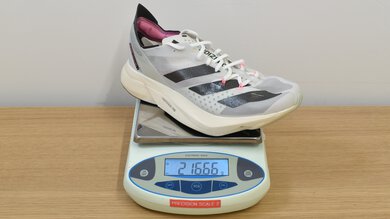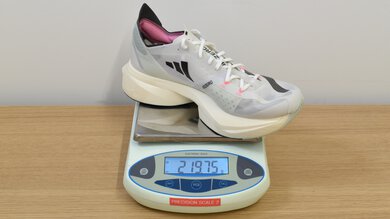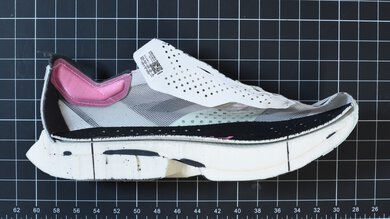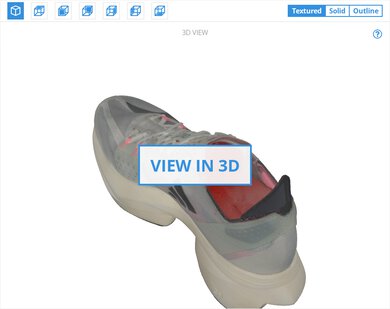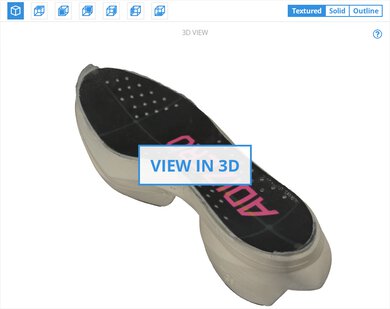The adidas Adizero Adios Pro 3 is a high-performance super shoe. It features adidas' signature Lightstrike Pro foam, paired with carbon ENERGYRODS that run parallel along the length of the shoe in place of a full carbon plate. The mesh upper helps to keep things light and cool during races, while the Continental rubber outsole offers substantial grip. Whether you're looking to shave time off your 10K PR or just need a premium shoe for intense interval sessions, the Adios Pro 3 brings a lot of tech to the table.
Our Verdict
The adidas Adizero Adios Pro 3 is a good choice for marathon racing, thanks to its lightweight design and impressive energy return. The shoe's substantial cushioning and carbon rods further enhance its suitability for long-distance events. However, its lateral stability is notably poor, which may require runners to exert additional effort to maintain balance over extended distances.
-
Good underfoot protection.
-
Carbon energy rods.
-
Very narrow arch due to cutout in the outsole.
-
Not the lightest race-day option.
For shorter races, the adidas Adizero Adios Pro 3 performs well, offering a firm forefoot that contributes to a snappy ride. Its lightweight construction and high-energy return make it a strong contender for shorter races, making it a solid choice for competitive runners.
-
Very snappy.
-
Forefoot is firm for toe-offs.
-
Carbon energy rods.
-
Not the lightest race-day option.
In terms of energy return, the adidas Adizero Adios Pro 3 is impressive, providing excellent responsiveness in both the forefoot and heel. This high-energy return translates to a more efficient stride, benefiting runners aiming for speed and endurance.
-
Very snappy.
The cushioning of the adidas Adizero Adios Pro 3 is good, offering adequate protection underfoot. Both the heel and forefoot cushioning are sufficient to absorb impact, contributing to a comfortable running experience.
-
Good underfoot protection.
Lateral stability is average on the adidas Adizero Adios Pro 3. This is mainly due to the narrow outsole arch width, a design choice made to minimize weight by cutting a part of the outsole. If you're able to maintain good form while transitioning, you shouldn't be impacted too much by this design. Also, the high stack height further affects balance during runs. While the carbon rods provide some structural support, runners will still need to focus on maintaining proper form to compensate for the shoe's instability.
-
Carbon energy rods.
-
Very narrow arch due to cutout in the outsole.
- 8.0 Marathon Racing
- 8.1 5K/10K Racing
Performance Usages
- 8.4 Energy Return
- 7.9 Cushioning
- 6.0 Lateral Stability
Changelog
-
Updated Apr 11, 2025:
We added a comparison to the Mizuno Wave Rebellion Pro 3 in the Heel Firmness box.
- Updated Apr 02, 2025: Converted to Test Bench 0.8.
- Updated Apr 02, 2025: Review published.
Check Price
Differences Between Sizes And Variants
We tested the adidas Adizero Adios Pro 3 in men's US size 9, as indicated on the label. Out shoe's color scheme is Crystal White/Night Metallic/Linen Green. This model is also available in several other colorways, including Cobalt Blue/Zero Metallic/Lucid Lemon, Core Black/Zero Metallic/Spark, and Off White/Aurora Ink/Flash Aqua. Additionally, a Pink Y-3 version is available. Wide versions are not available for this model.
Compared To Other Running Shoes
The adidas Adizero Adios Pro 3 is a super shoe known for its great energy return and snappy ride, making it a strong option for race day. However, it lacks stability compared to most running shoes and even many other super shoes, such as the Saucony Endorphin Pro 4. This means that while it's very snappy, there are better choices for longer races—for example, the Nike Alphafly 3, which offers more stability and is lighter: two important factors to stay efficient late in a marathon.
Within the adidas lineup, the adidas Adizero Boston 12 may seem similar, but the Adios Pro 3 is the better choice for all-out racing, whereas the Boston 12 is more versatile, handling both training and some racing. Meanwhile, the adidas Adizero Evo SL offers the same energy return and cushioning as the Adios Pro 3 but with better stability, all while being priced like a daily trainer and weighing just a single gram more.
For more options, check out our recommendations for the best running shoes.
The adidas Adizero Adios Pro 3 and the Nike Vaporfly 3 are both elite-level racing shoes, but they take different approaches to performance. The Adios Pro 3 offers slightly more energy return, a higher stack height, and more overall cushioning, creating a plush and dynamic ride. However, these factors also contribute to its heavier weight, whereas the Vaporfly 3 is much lighter, keeping things nimble and efficient. Both shoes lean toward the unstable side, but the Vaporfly 3 still has the edge for stability, making it a slightly safer choice for runners who struggle with lateral support at high speeds.
The Nike Alphafly 3 and the adidas Adizero Adios Pro 3 are high-performance super shoes offering similar energy return and overall cushioning. Their cushioning distribution differs, making them better suited for different foot strike styles. The Nike has more cushioning in the heel, providing a more forgiving landing for heel strikers, while the adidas has greater forefoot cushioning, favoring runners who land further forward. The Nike outshines the adidas shoe in lateral stability, thanks to its wider base. The adidas features a very narrow arch width, which can make it feel less stable. Also, the adidas is stiffer in the heel, while the Nike offers a softer feel. Runners preferring a firmer heel for more structure may lean toward the adidas, while those seeking a more cushioned landing may find the Nike more comfortable.
The Saucony Endorphin Pro 4 and the adidas Adizero Adios Pro 3 are both high-performance racing shoes, but they cater to slightly different strengths. The adidas offers more cushioning and better energy return, making it feel softer and more efficient. In contrast, the Saucony is notably more stable and features a stiffer forefoot, which helps create a dynamic, snappy ride, especially beneficial for shorter races like 5Ks and 10Ks. Additionally, the Saucony is slightly lighter, giving it a more agile feel. Overall, the Saucony is probably the better race-day option for most.
The adidas Adizero Adios Pro 4 and adidas Adizero Adios Pro 3 are both long-distance super shoes, but the Pro 4 brings some key updates. It's lighter, more responsive, and more cushioned thanks to a fully redesigned midsole. The upper was also reworked, resulting in a noticeably tighter fit in the forefoot. While both shoes are inherently unstable due to their tall stack and narrow platform, the Pro 3 was slightly more stable overall. The third version also has a firmer forefoot, which gives it an edge for shorter distances or runners who prefer a snappier toe-off.
The adidas Adizero Evo SL and the adidas Adizero Adios Pro 3 offer surprisingly similar performance. The Evo SL delivers comparable cushioning and energy return, making it an exceptional value option for those looking for race-ready features and true versatility. However, for peak racing performance, the Adios Pro 3 holds a slight edge thanks to its marginally lighter weight and full-length carbon fiber rods, enhancing efficiency.
The On Cloudboom Strike and the adidas Adizero Adios Pro 3 are similar in weight but differ in performance. The adidas is more energetic, delivering a higher level of energy return and a more propulsive feel, making it particularly well-suited for shorter-distance racing. In contrast, the On is more stable and more cushioned, providing better underfoot protection and making it a stronger option for marathon racing, where preserving leg freshness is a priority.
Test Results
Our outsole arch width measurement was taken from a slightly lower point on the arch of the shoe, when viewed from the outsole, due to an exceptional design cut-out on the medial side. We adapted our method slightly to better reflect the shoe's true stability profile.
The shoe delivers impressive responsiveness in the heel, translating into efficient energy transfer on each footstrike. Runners will feel noticeable bounciness, which is especially beneficial over longer distances where energy efficiency is crucial.
This shoe shines in forefoot energy return, offering a great bounce. This makes it particularly effective for faster-paced runners who land more on their forefoot, enhancing performance during competitive races or speed-focused sessions.
The adidas Adizero Adios Pro 3 provides good heel cushioning, giving runners a comfortable feel. While not plush, it absorbs impacts effectively, which is good for those seeking cushioning without sacrificing speed.
Forefoot cushioning in this shoe is very good, offering a comfortably firm feel that protects without compromising responsiveness. This cushioning strikes a good midpoint, benefiting runners who prefer a protective ride for faster-paced efforts.
The heel of the adidas Adizero Adios Pro 3 is on the firmer side. Under low forces, it's still relatively firm. But when more forces are applied—such as when you pick up the pace—the heel becomes a bit softer compared to other running shoes like the Nike Vaporfly 3. Still, it's not nearly as soft as some other super shoes like the Mizuno Wave Rebellion Pro 3.
Forefoot firmness in this model is notable, contributing positively to its racing performance, particularly for shorter races. This firmness supports a quick, responsive toe-off, appealing to competitive runners who favor a snappy, responsive feel.
Check Price
Comments
adidas Adizero Adios Pro 3: Main Discussion
Let us know why you want us to review the product here, or encourage others to vote for this product.
- 21010
Inside the review of the 32 inch model of this monitor, it was mentioned that the 27 inch model performs differently, can you guys please do a review of this monitor to show us the differences between the 32 inch and 27 inch? or can you at the very least mention what those differences are ??
- 32120
Does this monitor support HDR10+ format when using the apps like Amazon Prime, Disney+, etc? Also how does the upscaling work on this monitor for low resolution content considering it is supposed to be having a dedicated processor to help with that? And lastly, y'all have mentioned that the 27 inch version of this monitor is very different to this monitor- could you please tell us what are these big differences between them?
Seconded, I want to know the differences between the 27 inch and 32 inch models, like is it better? Is it worse?
- 21010
Wow this monitor is pretty disappointing, the contrast is awful and color accuracy doesn’t seem great, I was considering upgrading from an Odyssey G6 but now I don’t think so, I’m probably gonna wait until OLED monitors become more affordable or buy the previous gen Odyssey G70B since it’s somehow better than the G70D in every category
Edited 1 month ago: . - 43230
I’m very interested in learning more about this monitor, especially its brightness and contrast, as well as how it performs in HDR, I have the Samsung Odyssey G65B but I’m thinking about upgrading to a 4K monitor and this could be it, however brightness and contrast are a big concern for me and a major selling point for the G65B, I know this is an IPS panel so it’s obviously not gonna have contrast as good as a VA panel, I’m just wondering if this monitor has good enough contrast that the difference is minimal, I also want to know how bright this monitor can get and how it compares to the G65B / G65D and the previous-gen G70B
- 21010
I’m curious to see what changes the 2023 model of the Odyssey G5 has, it’s certainly interesting that Samsung keeps re-releasing this monitor every year or two, this is the third iteration of the same exact monitor if I’m not mistaken
- 43230
Hey, thanks for the review. Need an urgent info on this. I’m planning to get the G6 monitor and I have option to choose 27” or 32” for the same price. And I’m confused on what to get. Maybe you can help me out here. My main priority is text clarity (Since I’ll be working a lot on excel and reading docs, ofc along w gaming). I sit around 25” from the screen. Will going for the 32” significantly lower the text and image quality or it will be a very negligible difference I mostly won’t even notice?
I have a 32” and kinda like the size tho I usually don’t use all real estate but ig it’s just good to have. Especially since I’m getting it for free. Hence I’m a bit inclined towards the larger variant. I’d love to hear your thoughts on this. Thanks in advance!As far as I know there aren’t any major differences between the 27 inch and 32 inch models, even on Samsung’s website it doesn’t show any differences, which is interesting because with the G70B model for example. it shows a few differences between the 28 inch and 32 inch models, such as brightness and color accuracy, but with the G6 I think you can rest easy knowing they’re basically the same besides minor unknown differences that probably don’t make a difference.
As for the size, I went from a 32 inch TV to a 27 inch monitor and the difference in size isn’t major, but at the end of the day it depends on whether you’re willing to sacrifice pixel density and sharpness in favor of size, but imo 109 ppi (27 inch at 1440p) should be the minimum if you’re gonna be doing office work and stuff other than gaming, any lower and everything will feel pixelated and blurry, in fact I’m writing this comment from my 27 inch G6 monitor and even now the text feels a tiny bit blurry, it’s fine if you’re only gonna be gaming, but otherwise just get the 27 inch model or go for a 32 inch 4k monitor, I would definitely NOT go for a 32 inch 1440p monitor if you’re gonna be doing office work.
- 21010
As someone who owns the exact same monitor, i can say that this is absolutely true. Input lag is somewhat high at 60 Hz, but it doesn’t matter since you’ll be playing AAA story mode games at that framerate. In competitive games, which people are gonna play at 120+ FPS, input lag is low and neglectable unless you’re some professional player or someone freaked out about input lag.
Glad I’m not the only one who had a fantastic experience with this monitor, everything about it is great, especially for its price, at least where I live it was pretty cheap, quite a bit cheaper than other 1440p 240Hz monitors on the market, its only downside for me so far has been the colors in HDR, wouldn’t say they’re bad but they do look a bit washed out, I thought they’d be a little bit better, not sure if you had the same experience
- 43230
Does anybody know if the input lag has been fixed? its really that noticeable?
As someone who owns the 27 inch version of this monitor I can tell you it’s really NOT noticeable at all, it’s never gonna become an annoyance or a problem unless you constantly think about it, there’s also the possibility that the unit they received at RTINGS could’ve been faulty, nevertheless it’s not something you’ll notice in your day to day life
Now there has been a few software updates since this review came out and any one of them could’ve fixed the issue and that may be why I don’t notice it, but I can’t say for sure as Samsung never releases update notes for their software updates and I don’t have the tools to test input lag, but what I can tell you is this is a fantastic monitor, the response time and color accuracy are on par with some of the best IPS displays even though this is a VA monitor, and seeing as it’s a VA monitor you’re gonna have a really high contrast ratio, bright colors look really bright and dark colors look really dark which is fantastic and offers great immersion, especially if you play a lot of single player and story games, the monitor also has great brightness, it can go up to 600 nits in some cases which is higher than the competition, it’s basically an upgraded version of last gen’s Odyssey G7 monitor
- 21010
So Samsung released a software update (version 1602.4) for this monitor 2 days ago, anybody has an idea what changes (if any) they’ve made? And has anyone who installed the update notice any differences or improvements?
- 32120
You make good points, and even if Samsung hasn’t said anything, we haven’t been made aware of any updates improving the input lag either. Unfortunately because of limited testing resources, we can’t retest every monitor whenever there’s an update, but we’ll keep our eyes out for this one if we expect the input lag to be fixed. Regardless, our recommendations are best on more than just testing results, as we also consider price and availability, and considering this monitor costs more than the Dell Alienware AW2723DF and has some issues with flicker, if you want a 1440p 240Hz monitor, the Dell is the better choice.
I definitely get where you guys are coming from but keep in mind there are also people outside the US, Canada, and Europe who follow your reviews, and as it happens I live in the Middle East where Samsung products in general are much more available and cheaper than the competition in the 1440p 240Hz gaming monitors space, so as I stated earlier I ended up going with the 27 inch version of the G6, and so far it’s a really great monitor, things like colors, response times, and brightness are absolutely fantastic and can rival some of the best IPS monitors out there, and I actually found the some of the Smart TV features really useful, the only downside about this monitor is the input lag, which is not a major problem if you’re not a very serious and competitive gamer, and I also had issues with flicking at lower refresh rates, which no doubt I feel like Samsung is working on a fix for, and that’s precisely the reason we need you guys to keep an eye out for future software updates, because I do believe without these 2 issues this monitor is pretty much an instant buy for a lot of people, it’s really good for the price and easily available, so I really appreciate that you guys are willing to test future updates if they fix these issues.
- 21010
Hey! Thanks for reaching out and we appreciate the support. I definitely understand your concern about retesting monitors with firmware updates, but we have limited testing resources right now, so generally speaking, we only retest a monitor when there’s a firmware update that’s advertised to impact the test results. We aren’t aware of a firmware update that should fix the things you brought up, but we’ll keep our eyes out for it. That said, we did manage to get 1440p HDR - which you can see here - but 4k HDR doesn’t work. We still got a 4k signal, but only after changing a few settings. We had to disable Adaptive Sync and set the input label to ‘Home Theater System’ while still in Game Mode to get 4k from the PS5 - leaving the input label to ‘PC’ limits the resolution to 1440p. Although it does support HDMI 2.1, we couldn’t get it to accept 4k 120Hz signals no matter the setting. If you’re still having trouble with this, I would suggest contacting Samsung’s customer service to see if they can help you.
Thank you so much for getting back to me with this reply, I will for sure try your suggestions, though may I ask how you managed to get 1440p VRR on HDR, as in what settings did you use and how you managed to get those settings?
Also how do you disable Adaptive Sync while still having Game Mode enabled? Because from what I see on my monitor they’re basically the same setting, it just gets renamed depending on what input label you set it to, on PS5 I have it on “Game Console”, is “Home Theater System” generally a better setting?
- 32120
I would love it if you guys could continuously re-test things like input lag (which seems a little bit too high even for a Tizen monitor, other Samsung smart monitors have better input lag), PS5 and HDR compatibility, etc, with every (or at least every few) software updates Samsung releases for this monitor, because I have the 27 inch version of this monitor and I found out that when you have Game Mode enabled and you’re on PS5 you can only play HDR for up to 1080p not 1440p, I’m not sure if I’ve done something wrong in the settings or if that’s only for the 27 inch version OR if support for 1440p HDR on PS5 is coming in a later update, but that’s something I would like you guys to continuously test with every few updates they release.
Also when you’re on Game Mode on PS5 you can’t get 2160p even though the monitor supports this resolution when you have Game Mode disabled, and another thing I noticed is this monitor has HDMI 2.1, which should support 2160p (upscaled) at 120Hz on PS5 since the PS5 requires HDMI 2.1 to get 4k 120Hz, but for some reason you don’t get that with this monitor, this is something I’m also not sure if it’s coming in a later update or if the monitor has a weird quirk that makes it not able to support it, but I’d love to find out when they make changes and if I should always update to the latest versions.
Edited 1 year ago: . - 54340
Would love to see a review of this monitor, I know you guys already reviewed the 32 inch version of the G6, but I’m wondering if there are any other differences between the 27 inch and 32 inch besides the display size


